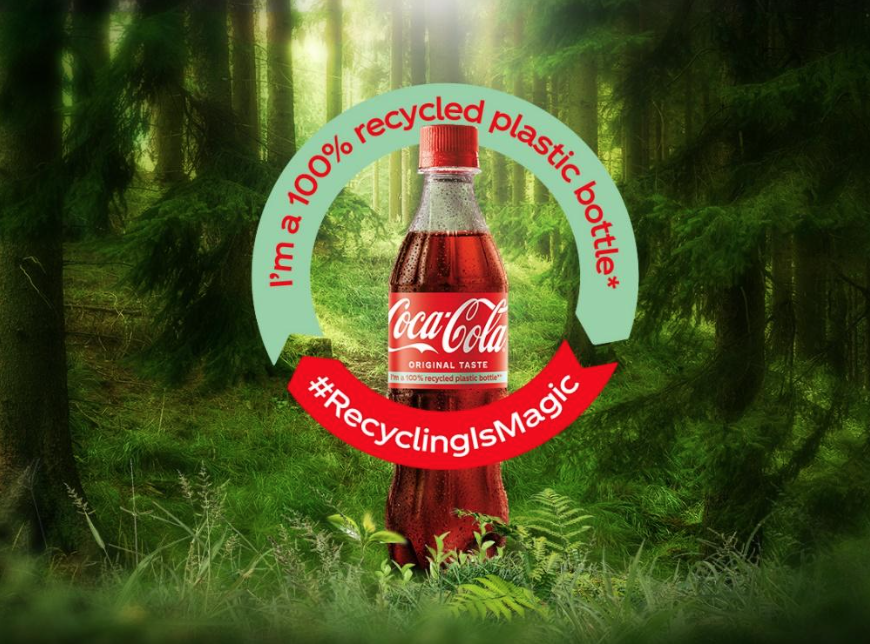In a world where people are becoming more aware of the importance of being environmentally friendly, the recent Coca-Cola advertisement that came from the sustainability campaign was spot on. With the background depicting a lush green forest, the ad is clearly and publicly placed on the company’s official website and popular sustainability blogs where it shows a Coca-Cola plastic bottle with the tagline, ‘I am a 100% recycled plastic bottle’. This has got to be as aesthetically appealing as it is effective in a message that not only tells the audience that Coca-Cola is serious about recycling but also about its commitment towards the environment. By placing the easily recognizable red and white label that forms the image of the company in an environmentally-friendly background, the company not only reinforces its environmental stance but also tries to change the consumer’s perception and decision-making process to be more ecologically friendly.
The core message of Coca-Cola’s advertisement is clear: the company is making strides towards sustainability in their products by making their bottles from 100% recycled material. This message is most effectively conveyed through the use of vibrant, natural imagery and direct text on the bottle, which claims a direct environmental benefit. The design of the ad uses the color green which is commonly associated with nature and sustainability, and this strengthens the overall idea of the advert concerning environmental conservation. The hashtag #RecyclingIsMagic complements this effectively by adding a touch of wonder and being proactive to the notion of recycling, implying that such practices can turn the old into new in a manner that is often magical.
The advertisement put up by Coca-Cola is very much targeted at changing the attitude of consumers into a more environmentally friendly manner, particularly by urging people to buy products that are packed with recycled materials. Therefore, while stating that its bottles are recycled, what Coca-Cola is doing is not merely selling a product but persuading consumers to change their ways for the better of the environment. The advertisement successfully makes its audience have a positive predisposition toward recycling and choose products that do not harm the environment but rather support it. This approach is a smart choice since it makes it easier to align the brand with the corporate image, and appeals to a demographic of the consumers who are conscious about environmentally-friendly products.
The intended target audience of this advert not only encompasses regular Coca-Cola consumers but also a class of people who are environmentally conscious and have a preference for products that are eco-friendly. This demographic may be younger, ranging from the millennial customer base and Gen Z consumers, who survey reveal are more willing to engage brands that exhibit comprehensive CSR programs. In targeting these eco-aware consumers, Coca-Cola not only widens its consumer base but also taps into a niche market that has a penchant for companies that actively practice environmental responsibility. Furthermore, this strategy gives Coca-Cola a chance to capture a new untapped market with the potential to change its perception of the brand and consumption patterns for the long-term future as the world becomes more environmentally conscious.
However, the effectiveness of this advertisement can be critically examined based on the possibility of greenwashing issues. Although the ad asserts that the bottles depicted are made from 100% recycled material, it is silent on other major ecological considerations, such as the total carbon footprint of Coca-Cola production, energy utilization, or the biodegradability of the bottles in question. This selective disclosure may make it possible for smart consumers to doubt the extent of Coca-Cola’s commitment to environmental practices. It is thus important that claims made by Coca-Cola in the advertisement are perceived as credible by the public, and the company’s ability to convincingly present real efforts towards sustainability that transcend the use of recycled material in packaging. The intended message could be reversed by consumer skepticism when the broader environmental context is dismissed or poorly considered.
In conclusion, by examining the elements of the ad and analyzing the text and visuals, it is evident that the Coca-Cola advertisement successfully appeals to consumers by promoting its recycled bottles and associating the brand with environmental sustainability. A critical evaluation of this specific advert through the use of advertising theories such as ethos, pathos and logos depicts a clear appeal to both reason and passion whereby consumers are drawn into the story about sustainability. However, for the advertisement to serve the purpose of developing long-term credibility and trust among the consumers, it is vital for Coca-Cola Company to ensure that its business practices are aligned to sustainable values presented in the advertisement. Being upfront about these challenges and opportunities in the company’s marketing communications will be critical for Coca-Cola to sustain its market position as an environmentally sensitive company in the eyes of more corporate consumers.
Bibliography
Chatzopoulou, Elena, and Adrian De Kiewiet. “Millennials’ evaluation of corporate social responsibility: The wants and needs of the largest and most ethical generation.” Journal of Consumer Behaviour, vol. 20, no. 3, Oct. 2020, pp. 521–34. https://doi.org/10.1002/cb.1882.
Lin, Zishen. “Reasons and analysis of Coca-Cola’s greenwashing.” BCP Business & Management, vol. 33, Nov. 2022, pp. 23–28. https://doi.org/10.54691/bcpbm.v33i.2714.
Narayanan, Sajith. “Does Generation Z value and reward corporate social responsibility practices?” Journal of Marketing Management, vol. 38, no. 9–10, May 2022, pp. 903–37. https://doi.org/10.1080/0267257x.2022.2070654.


David
Your work is well organized and coherent which allows readers to easily understand and engage with your message. Your analysis on Coca-Cola’s eco-friendly advertisement not only analyses the visual and textual but the impact on consumers behavior in today conscious marketplace. I like the idea of using ethos, pathos, and logos to support your point but not everyone can decode such information, so I believe leading with an example to elaborate on these topics would be helpful. Your identification of Coca-Cola target audience being young consumers who prioritize environmental consciousness enriches your analysis. Good job pointing out the potential greenwashing from Coca-Cola but I’m curious if the company has had any similar issues in the past. Your conclusion effectively explains the key points discussed throughout the paper and the need for Coca-Cola to align its practices with the sustainable values they promote. You critically analyzed Coca-Cola eco-friendly ads and its marketing strategy Great job.
David
Your work is well organized and coherent which allows readers to easily understand and engage with your message. Your analysis on Coca-Cola’s eco-friendly advertisement not only analyses the visual and textual but the impact on consumers behavior in today conscious marketplace. I like the idea of using ethos, pathos, and logos to support your point but not everyone can decode such information, so I believe leading with an example to elaborate on these topics would be helpful. Your identification of Coca-Cola target audience being young consumers who prioritize environmental consciousness enriches your analysis. Good job pointing out the potential greenwashing from Coca-Cola but I’m curious if the company has had any similar issues in the past. You identified the risks of greenwashing but could further strengthen your point by providing specific examples or statistics regarding Coca-Cola’s overall environmental impact; This will strengthen your view about consumer skepticism and the importance of transparency. Additionally, the use of scholarly sources to solidify your point is applaudable enhances the credibility of your analysis. Overall your analysis discusses about Coca-Cola advertisement strength and challenges the company might face in the future if they don’t align its practices with the sustainable values they promote in the market.